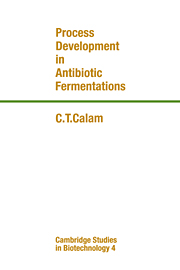Book contents
- Frontmatter
- Contents
- Preface
- Part 1 Background
- Part 2 Process development in the laboratory
- 7 Laboratory fermentation process development
- 8 Assessment and understanding of experimental results
- 9 Strain improvement
- 10 Methods for laboratory process development
- Part 3 Industrial fermentation plants and pilot plants
- Postscript
- Bibliography
- References
- Index
8 - Assessment and understanding of experimental results
Published online by Cambridge University Press: 05 February 2012
- Frontmatter
- Contents
- Preface
- Part 1 Background
- Part 2 Process development in the laboratory
- 7 Laboratory fermentation process development
- 8 Assessment and understanding of experimental results
- 9 Strain improvement
- 10 Methods for laboratory process development
- Part 3 Industrial fermentation plants and pilot plants
- Postscript
- Bibliography
- References
- Index
Summary
Introduction
At the end of a fermentation experiment, a set of results will be obtained. This may consist of antibiotic titres and some pH values, or, in a large-scale culture trial, there may be many results covering antibiotic production, growth, and other factors. An immediate requirement is to check the general appearance and behaviour of the culture to establish its normality and reliability. The analytical data can then be collected and examined.
As a rule, antibiotic production is a key indicator, while other factors express the manner of growth and metabolism. From these data it is possible to obtain a picture of how the fermentation works, and to obtain ideas for its future development.
It is possible to visualise the fermentation mechanism as like a wire sculpture, in which wires rise from the base, intertwine, and form a network tower. Here, the wires represent the reactions or material flows described in Chapters 3 and 4. One of these wires might represent growth, others might represent respiration and the use of nutrients and the behaviour of other reactions, but the most important one would represent antibiotic synthesis, which should ascend to the maximum possible height.
If the sculpture was based on theory, there would be many wires; in reality only a few reactions are monitored, so there would be only a few wires. These would represent factors that could be measured continuously, like pH, feed, carbon dioxide, and oxygen. But with growth and antibiotic production, measured at intervals, only beads would appear representing these spot values. In plant work, the sculpture might consist only of these beads.
- Type
- Chapter
- Information
- Process Development in Antibiotic Fermentations , pp. 93 - 103Publisher: Cambridge University PressPrint publication year: 1987

